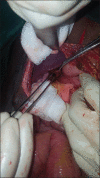Peritonitis by perforation of the gall bladder of typhoid origin in children
- PMID: 36960511
- PMCID: PMC10209755
- DOI: 10.4103/ajps.ajps_144_21
Peritonitis by perforation of the gall bladder of typhoid origin in children
Abstract
Peritonitis by perforation of the gall bladder of typhic origin is a rare condition. In Côte d'Ivoire, no studies to our knowledge have addressed the vesicular complications of typhoid fever in children. The aim of this work was to describe the epidemic-clinical, therapeutic and evolutionary aspects of the perforation of the gall bladder of typhic origin in subjects under 15 years of age. In 6 years, five children showed a vesicular perforation of typhic origin or 9.4% of peritonites of typhic origin. They were 5 boys with an average age of 07.4 years 5-11 years. The children were from low socioeconomic backgrounds. No history was noted. Clinical examination revealed peritoneal syndrome. X-ray of the abdomen without preparation carried out in all children had objectified a diffuse greyness. Leucocytosis was present in all cases. Treatment in all children initially consisted of resuscitation and antibiotic therapy with the 3rd generation cephalosporin and an imidazole. Surgical exploration revealed gangrene and perforated gallbladder without damage to other organs or the presence of stones. A cholecystectomy was performed. The following procedures were simple in 4 patients. A patient died of sepsis following postoperative peritonitis by biliary fistula. Perforation of the gall bladder of typhic origin is rare in children. It is usually discovered at the stage of peritonitis. The treatment combines antibiotic therapy and cholecystectomy. Systematic screening should reduce the progression to this complication.
Keywords: Biliary perforation; gall bladder; peritonitis; typhoid fever.
Conflict of interest statement
There are no conflicts of interest.
Figures
References
-
- WHO. Typhoid Fever and Other Invasive Salmonellosis. Standards of Vaccine Preventable Disease Surveillance. 2018. [Last accessed on 2021 Nov 24]. Available from: https://www.who.int/immunization/monitoring_surveillance/ burden/vpd/WHO... .
-
- Ugwu BT, Yiltok SJ, Kidmas AT, Opaluwa AS. Typhoid intestinal perforation in north central Nigeria. West Afr J Med. 2005;24:1–6. - PubMed
-
- Kouame BD, Ouattara O, Dick RK, Gouli JC, Roux C. Diagnostic, therapeutic and prognostic aspects of intestinal typhoid perforations in children of Abidjan, Côte d'Ivoire. Bull Soc Pathol Exot. 2001;94:379–82. - PubMed
-
- Yaokreh JB, Coulibaly O, Kouame DB, Koffi KM, Tembely S, Kouame YS, et al. Descriptive study of peritonitis in children in Yopougon University Hospital. Rev Int Sci Med. 2015;17:173–7.
-
- Gali BM, Ali N, Agbese GO, Duna VD, Dawha SD, Ismai GI, et al. Gallbladder perforation complicating typhoid fever:Report of two cases. Niger J Med. 2011;20:181–3. - PubMed
Publication types
MeSH terms
Substances
LinkOut - more resources
Full Text Sources
Miscellaneous



